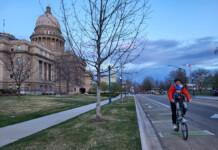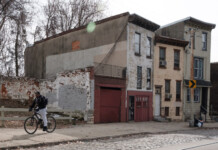
Lays flat on the road, Looks grey (not like new asphalt), Smoother for bikes, Less expensive
By Becka Roolf – Bicycle/Pedestrian Coordinator, Salt Lake City Division of Transportation
June 2011 – Last summer’s chip seal on Emigration Canyon Road stirred up many strong feelings in the bicycling community – more than just chips were flying. Salt Lake County chip sealed two sections of the canyon road using a modern chip seal process that includes spreading tar (technically known as bitumen) on the road, spreading chips, rolling the chips into the tar, sweeping up loose chips, and sealing the chips to the seals with another thin layer of tar (a treatment called a fog seal). Still, the resulting chip seal was not very pleasant under my 23 c tires, and reportedly has not worn in well for bikes.
Last summer, I was very glad that Salt Lake City (in contrast to the County)has had an informal policy of not chip sealing bike lanes for the past several years – a decade or more. But as we come up on this year’s construction season, Salt Lake City is, at my own request, considering changing our chip seal policy to include bike lanes.
Why? Well, we looked at some streets that had been chip sealed on the road, but not in the bike lane. The bike lane is rough and gathering potholes. In the long run, this bike lane will continue to fall apart. The travel lane that was chip-sealed four years ago provides a much better riding surface than the untreated bike lane.
Bicyclists have been long-time advocates for better pavement on the roads. Way back in the 1880s, the League of American Bicyclists (known until the 1990s as the League of American Wheelmen) was founded with a primary mission of advocating for paved streets.
Even though we bicyclists aren’t as heavy and don’t cause as much damage to the roads as motor vehicles (especially trucks), today’s bike lanes still benefit from surface treatments. The oils from the tar soak into the asphalt and help hold it together – sort of like using conditioner on your hair. The chips themselves add structural integrity to the road and help keep potholes from forming.
Slurry seals, historically preferred as a treatment for the City’s bike lane streets, just don’t offer the same boost to a street’s integrity as a chip seal. Slurry seals only have sand mixed with the tar and a setting agent; covering asphalt cracks over with sand often results in the cracks coming right back through. The conditioning treatment is still there, but not the same pothole-preventing properties as a chip seal.
Salt Lake City uses a different kind of stone in our chip seal than does Salt Lake County. The City’s stones are flatter and lay more smoothly on the road, especially after a couple passes with a heavy roller. According to Michael Leetham, the supervisor of the City’s chip seal crews, the City switched to the stone chips after we had a failure of a slag-based product several years ago, resulting in the chip seal breaking up and washing into the gutters.
The County is continuing to use a slag product (albeit a superior product to the one that failed in Salt Lake City). This costs more in materials than does Salt Lake City’s stone chips, but is more durable. As a result, the County’s treatment may save in the long run on staff time. Salt Lake City is continuing to use the stone chips and does not plan a return to slag.
In last summer’s Emigration debate, some bicyclists suggested that a better solution is to save up and repave with asphalt, instead of doing a chip-seal. But a full repaving job costs about 9 times as much as a chip seal. A chip seal is a very cost-effective way to extend the life of our current streets. With the regular “conditioning” oils of slurry seals and chip seals, the life of asphalt may be extended by decades.
This summer, Salt Lake City will experiment with a different treatment on Indiana Avenue, a “cape seal.” A cape seal is a chip seal with a slurry seal on top of it. A cape seal provides the structural benefits of a chip seal with the smooth finished surface of a slurry seal. The downside is that a cape seal costs almost twice as much as a chip seal alone – not helpful as public agencies seek to spread thin budgets to cover as many streets as possible.
This summer, the City will chip seal a couple street segments with bike lanes, as a pilot project. These streets are in areas with truck traffic, such that the road surface is already deteriorated beyond what a slurry seal can restore. Please do check out the upcoming chip seals on 1700 S between 300 W and 900 W; on 4400 W between 700 S and California; and on 4800 W between 1100 S and California. Please send any comments to bikeslc@slcgov.com or call me at 801-535-6630.
If you have questions on the County’s chip seal program, please contact Colin Smith, Salt Lake County Bicycle Coordinator at CCSmith@slco.org or 801-468-2500. .
Neither the City nor the County’s chip-seal is completely ideal for bicyclists – certainly during the week when the chip-seal is being spread and rolled– but, after careful consideration, I believe that either treatment in the long run is preferable to road deterioration and potholes.








